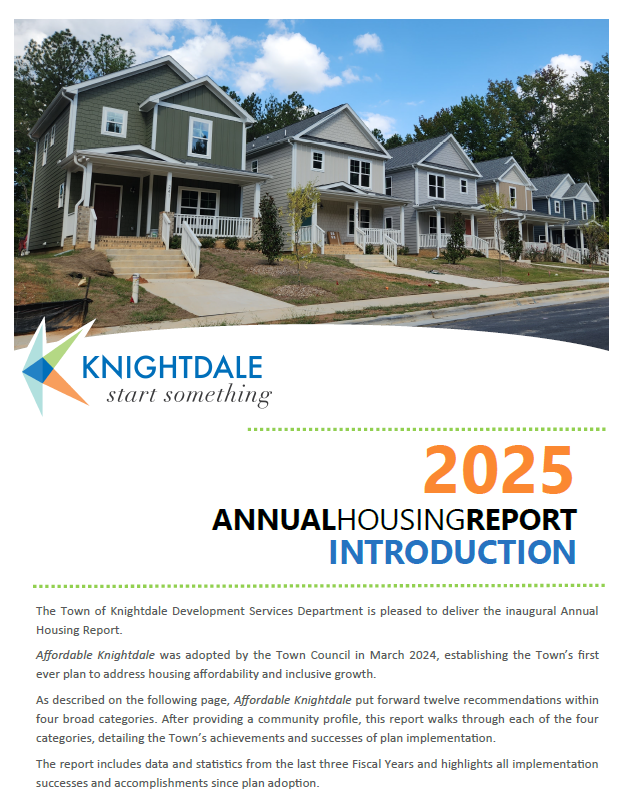Thank you for your participation!
Town Council adopted the Affordable Knightdale Plan on March 20, 2024. The Town greatly appreciates all the community engagement throughout the planning process. From housing advocates, the general public, municipal partners, the Housing Committee to Town Administration and Elected Officials, your voices and input were critical to shaping the plan.
PLANNING PROCESS TIMELINE & COMMUNITY OUTREACH
The process kicked off at the beginning of 2023 with the first few months focused on community outreach, including stakeholder interviews, pop-up events, and a public opinion survey. A draft plan was released in January 2024 for public comment and an open house was held in early February. On March 11, 2024 the Land Use Review Board recommended adoption of the plan, and on March 20, 2024 the Town Council adopted the Affordable Knightdale Plan.
Various opportunities were provided throughout the planning process for Knightdale residents, workers, business owners, leaders, and stakeholders to provide thoughts and feedback on the plan.
PLAN OVERVIEW
Affordable Knightdale(External link) puts forward a path that will aid in the realization of the Town's ambitious vision for an inclusive, livable, and affordable future. With the guidance and expertise of UNC-Greensboro's Center for Housing & Community Studies, an action-oriented plan was developed that not only prioritizes affordable housing, but emphasizes the importance of inclusive and equitable growth.
The following six tasks create a roadmap for the Town to address the affordable housing challenges, with a 10-year implementation goal:
- Explores the social, economic, and demographic forces that contribute to housing challenges.
- Describes the meetings with experts and gathering of neighborhood residents to talk about housing needs and solutions.
- Sets the goals and articulates the guiding principles for affordable housing action.
- Makes recommendations for action based on the data and information gathered.
- Sets forth a plan for implementing the recommendations over the next ten years and measuring success
- Clarifies the housing challenges for the Town, promotes outreach and education, and informs public opinion to support change.
PLAN RECOMMENDATIONS
The plan establishes twelve recommendations that encompass a variety of methods, approaches, and interconnected program and policy goals. The recommendations fit under four main categories: Funding, Process, Subsidy, and Demonstration, and are summarized below.
- Affordable Housing Trust Fund. This serves as a pool of resources especially dedicated to the creation and preservation of affordable housing. Funding can be from a variety of sources, including Town budget, voluntary developer payments, new or existing tax revenues, or donations.
- Land Acquisition Policy. A policy allowing for the strategic acquisition of land parcels to be dedicated to affordable housing development. Reasons for acquisition include immediate development, holding for future development, and preservation of existing affordable housing.
- Capacity Building & Community Engagement. Hiring a dedicated staff member to oversee the implementation of the plan and the establishment of the housing resource center.
- Housing Advisory Board. This is an advisory community panel made up of community representatives that will assist with Plan implementation and make recommendations about affordable housing development to the Town Council and Town staff.
- Zoning Incentives. The Plan recommends modifications to the Unified Development Ordinance that would permit added residential density and streamlined procedures and create incentives to create affordable housing.
- Gap Financing. This can be utilized by local governments to help reduce financing costs, making it financially feasible to make rents affordable to lower-income households than might otherwise be possible. Gap financing can be provided at a local, county, state, or federal level.
- Development Partnerships. Partnerships between the Town of Knightdale and nonprofit developers to preserve and create affordable rental housing and homeownership opportunities.
- Direct Assistance. This is typically small-scale interventions that local governments can do to directly assist eligible homeowners and renters with obtaining or keeping affordable housing.
- Expand Housing Options. This recommendation promotes the development of housing types outside of the single-family detached realm. This could include smaller homes, accessory dwelling units, and cottage court concepts.
- Mixed-Income Focus. This concept proposes to build mixed-income neighborhoods by incorporating affordable homes or lots into market-rate neighborhoods or subdivisions.
- Permanent Affordability. Through community land trusts and other ownership structures, ownership opportunities are offered to lower-income homebuyers and ensure long-term affordability.
- Inclusive, Livable Environment. All planning processes for housing should incorporate principles of walkability, bikability, transit-oriented design, and proximity to schools, jobs, shops, and services.
HOUSING REPORT
An annual report is a direct recommendation from Affordable Knightdale. This document is meant to report on key housing metrics, account for all spending, and provide a progress report on plan implementation.
We invite you to read the 2025 Housing Report to see Knightdale's progress toward implementing the recomendations and goals of Affordable Knightdale. This inaugural report captures all achievements since plan adoption in March 2024.
